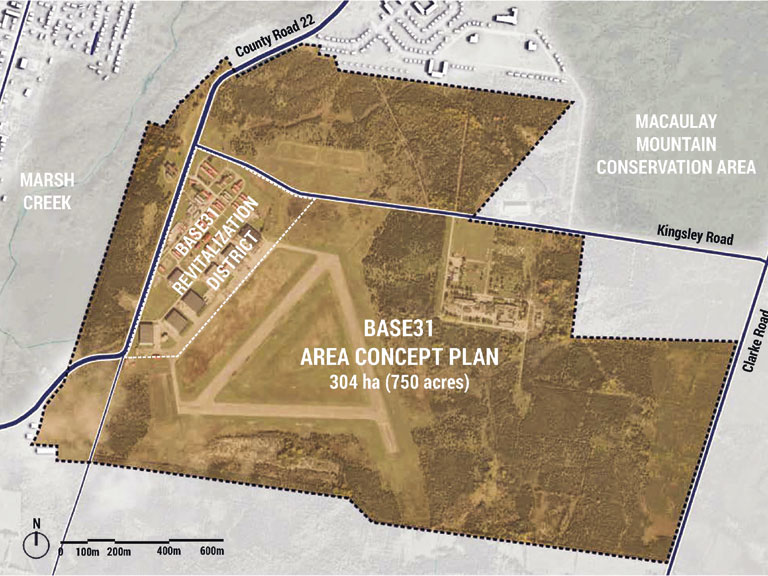County News
A show of faith

Council approves Base 31 plans
A partnership known collectively as Base31 took a big step forward last week toward redeveloping the former air force base near Picton. The property spans about 255 hectares (630 acres) and includes dozens of hangars, barracks and storage buildings that were constructed for the former British Royal Air Force 31 Bombing and Gunnery School.
A substantial package of agreements, studies, reports and plans, including an amendment to the County’s Official Plan, breezed through a planning meeting last week at Shire Hall without much friction.
The Official Plan Amendment (OPA) updates the Picton Urban Centre Secondary Plan to redesignate the property to align with the Area Concept Plan that identifies development blocks, open spaces and major infrastructure. The OPA determines, in general terms, where homes and businesses will be built, as well as the roads, cables and pipes required to connect the large-scale development—as many as 7,500 homes—to the existing community.
The developers have done a masterful job of softening the regulatory soil—injecting new vitality and energy into the slowly decaying property. Arts and entertainment programming over the past couple of years has offered a glimpse of what the land can be—and how it might complement Prince Edward County’s arts and cultural economy. In doing so, it has generated considerable goodwill in the community and on County council.
So, it met a mostly receptive audience at the planning meeting last week. There were some questions about land remediation, infrastructure requirements, and who would pay. There were gentle questions about affordability, too. Few were inclined to challenge the developer or hinder its plans.
Sophiasburgh councillor Bill Roberts spoke for many.
“Base31 is transformative,” said Roberts. “I hold it as a matter of faith that it will be a positive transformation for Prince Edward County.”
He asked the builder how many homes might be built each year. It was too early to tell, was the response. He tried again. Still nothing tangible.
“I wish I had answers, but maybe they will come later,” Roberts demurred. “I am, however, supportive.”
It was clear this would be an easy night for the applicant.
Not all of council was as obliging, however.
Wellington councillor Corey Engelsdorfer suggested that more work was needed before he could support approving the OPA. He noted that the County hasn’t yet prepared a Master Serving Plan for Picton governing the expansion of services, it doesn’t have an area-specific development charge mechanism to pay for infrastructure upgrades, and the environmental assessment looking at water supply alternatives for the town isn’t yet complete. He worries that giving the developer the green light before Council had these answers is premature.
“Are we setting something in motion that we can’t control or stop at some point?” asked Engelsdorfer.
The consulting planner, Stephen Willis, suggested the train was already underway.
“In 2015, Council made a decision that these lands would be developed,” said Willis. That decision set the wheels in motion for the County to come up with and implement infrastructure strategies to enable this land to be developed, explained the planner.
After that, most questions felt like throwing pennies at a moving locomotive.
Public consultation? A Picton councillor was assured that the public would be invited to submit concerns and questions at future development planning stages, including zoning (except the portion subject to a Ministerial Zoning Order), site plan agreements and plan of subdivision.
Athol councillor Sam Branderhorst asked about land contamination and a remediation plan.
Willis explained to the council member that this was not required by the OPA, but assured the council member such remediation would form part of future approvals.
On the recommendation of a deputant, Dorothy Bothwell, Kate McNaughton urged the developer to replace a word in the OPA regarding affordability. Rather than “contemplate” a minimum of five per cent, replace it with the word “require” five per cent. The partners agreed to the change.
Several council members dropped any pretence of scrutiny, instead becoming advocates for the project.
“You’ve mentioned momentum,” said Councillor Roberts in response to Tim Jones, a partner in PEC Community Partners (Base31) presentation. “I was at a conference at the Aga Khan Museum that brought the development community together. One of the comments I noted was around the notion of delay. One of the panel members said that every month of delay translates into $3 per square foot in additional cost to the finished cost. Is this your understanding?”
Jones used the question to underline the point that when the developer acquired the land it was designated for development.
“We took a huge leap of faith,” said Jones. “We invested a huge amount of money. It would be a major setback for us if the County were to say let’s take a break and work out all the details. Developments require confidence. But they also require councils to keep things moving with an understanding the process is going to allow us to figure these things out as we go.”
“It is important to us that we have your support as we move through this process. We think we have demonstrated an ability to work collaboratively to find solutions.”
“I agree,” said Roberts. “I believe the word momentum is very important.”
A queue of council members then praised the development team, signalling their collective desire to support the project.
The OPA passed and is expected to be ratified at a council meeting on January 9.

Comments (0)